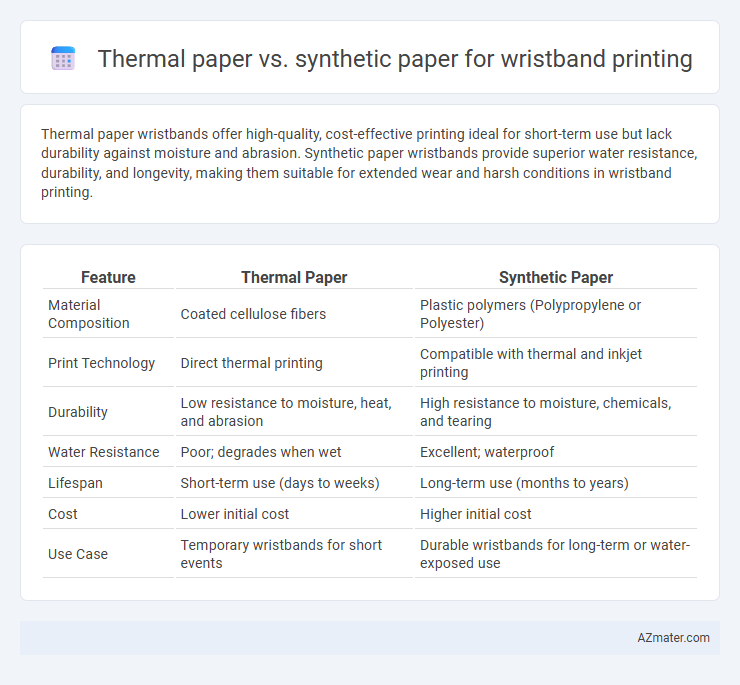Thermal paper wristbands offer high-quality, cost-effective printing ideal for short-term use but lack durability against moisture and abrasion. Synthetic paper wristbands provide superior water resistance, durability, and longevity, making them suitable for extended wear and harsh conditions in wristband printing.
Table of Comparison
| Feature | Thermal Paper | Synthetic Paper |
|---|---|---|
| Material Composition | Coated cellulose fibers | Plastic polymers (Polypropylene or Polyester) |
| Print Technology | Direct thermal printing | Compatible with thermal and inkjet printing |
| Durability | Low resistance to moisture, heat, and abrasion | High resistance to moisture, chemicals, and tearing |
| Water Resistance | Poor; degrades when wet | Excellent; waterproof |
| Lifespan | Short-term use (days to weeks) | Long-term use (months to years) |
| Cost | Lower initial cost | Higher initial cost |
| Use Case | Temporary wristbands for short events | Durable wristbands for long-term or water-exposed use |
Introduction to Wristband Printing Materials
Thermal paper and synthetic paper are the primary materials used for wristband printing, each offering distinct advantages in durability and print quality. Thermal paper provides high-resolution printing at a lower cost, ideal for short-term use in events or hospitals, whereas synthetic paper ensures superior water, tear, and chemical resistance, making it suitable for long-term applications. Selection between these materials depends on the specific requirements for wristband lifespan, environmental exposure, and budget constraints.
What is Thermal Paper?
Thermal paper is a specially coated paper designed to react to heat during the printing process, producing images without the need for ink or ribbons. It offers high-resolution printing ideal for wristbands, ensuring clear barcodes and text that are essential for event management and healthcare identification. Thermal paper is cost-effective and quick to use but can be sensitive to heat, light, and abrasion, which may affect durability.
What is Synthetic Paper?
Synthetic paper is a durable, tear-resistant material made from synthetic polymers designed to withstand harsh environmental conditions. Unlike thermal paper, synthetic paper offers superior water, chemical, and abrasion resistance, making it ideal for wristband printing in settings such as events, healthcare, and outdoor activities. Its compatibility with various printing technologies ensures high-quality, long-lasting wristbands that maintain legibility and durability.
Durability Comparison: Thermal vs Synthetic Paper
Thermal paper wristbands are cost-effective but prone to fading, tearing, and moisture damage, making them less durable for long-term or high-activity use. Synthetic paper wristbands, made from polypropylene or similar materials, offer superior durability with resistance to water, chemicals, and abrasion, ensuring legibility and integrity throughout extended events or harsh conditions. The choice hinges on application requirements, where synthetic paper provides enhanced longevity and reliability compared to the more vulnerable thermal paper.
Print Quality: Thermal Paper vs Synthetic Paper
Thermal paper offers high-resolution print quality ideal for short-term wristband use, producing sharp and clear images with excellent contrast due to its heat-sensitive coating. Synthetic paper provides superior durability and print longevity, maintaining print integrity under moisture, smudging, and abrasion, making it ideal for long-term or outdoor events. While thermal paper excels in initial print clarity, synthetic paper ensures sustained readability and resistance to environmental challenges in wristband applications.
Water and Chemical Resistance
Thermal paper wristbands offer limited water and chemical resistance, making them prone to smudging and fading when exposed to moisture or cleaning agents. Synthetic paper wristbands provide superior durability with enhanced resistance to water, chemicals, and abrasion, ensuring clear legibility throughout extended use. For environments requiring prolonged exposure to liquids or harsh chemicals, synthetic paper wristbands deliver more reliable performance and longevity.
Cost Analysis for Wristband Printing
Thermal paper wristbands offer a lower upfront cost, making them ideal for short-term events with limited budgets, but they tend to have a shorter lifespan and are less resistant to moisture and tearing. Synthetic paper wristbands, although more expensive initially, provide enhanced durability, water resistance, and a longer usable life, reducing replacement costs and improving overall value for multi-day or high-activity use. Evaluating total cost of ownership involves balancing material expenses against durability and replacement frequency to determine the most economical choice for specific wristband printing needs.
Environmental Impact and Sustainability
Thermal paper wristbands are often coated with chemicals like BPA that can pose environmental hazards during disposal and have limited biodegradability. Synthetic paper wristbands, made from plastic-based materials such as polypropylene, offer better durability and water resistance but contribute to long-term plastic waste and are less biodegradable. Choosing between thermal and synthetic paper wristbands involves balancing the trade-offs between chemical contamination and plastic pollution in sustainability efforts.
Application Suitability: Events, Healthcare, and More
Thermal paper wristbands offer cost-effective, high-speed printing ideal for large events and short-term use, providing clear barcode readability and quick application. Synthetic paper wristbands excel in healthcare and environments requiring durability, moisture resistance, and chemical tolerance, ensuring long-lasting identification without smudging or tearing. Event organizers prioritize thermal paper for disposable convenience, while hospitals and industrial settings benefit from synthetic wristbands' robustness and reliability under harsh conditions.
Choosing the Right Paper for Your Wristband Needs
Thermal paper offers cost-effective printing with sharp, high-contrast images ideal for short-term wristbands used in events and healthcare settings. Synthetic paper provides superior durability, water resistance, and tear-proof qualities, making it suitable for long-term wristbands in outdoor or harsh environments. Selecting between thermal and synthetic paper hinges on factors such as required lifespan, environmental exposure, and budget constraints for your wristband application.

Infographic: Thermal paper vs Synthetic paper for Wristband printing
 azmater.com
azmater.com